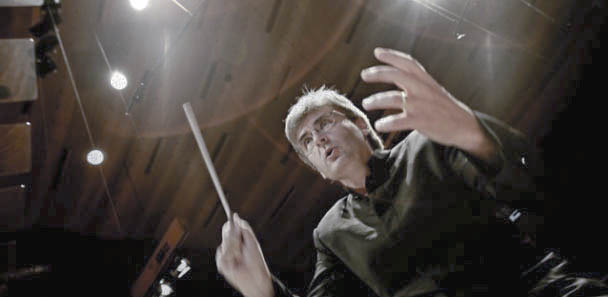 January 24, 2013. Roy Thomson Hall, Toronto.
January 24, 2013. Roy Thomson Hall, Toronto.
Visiting conductor Thomas Dausgaard, marched the Toronto Symphony, enlarged to the size of a small army, through the tragedy and triumph of Mahler’s 80-minute epic. As a prelude to his elegantly programmed performance, Dausgaard personally introduced two 10-minute works, a mature Schubert and a juvenile Mahler, performed by a quintet of four TSO Principal Strings and the Gryphon Trio’s pianist James Parker.
Schubert’s single Allegro movement in the C minor Quartettsatz of 1820 opens with tension– a fly-buzz of strings swirls drunkenly and resolves into a lilting lyric that expands outward in dynamic ripples of deeply felt passion. Dausgaard remarked that this work hints at the tragic tone of Schubert’s later quartets. The Mahler Piano Quartet in A Minor, is modelled on Schumann and Brahms (not surprising in a sixteen-year-old Vienna Conservatory student). Parker’s piano had a pleasant transparency in duet with Joseph Johnson’s shapely cello part, and concertmaster Jonathan Crow got a singular effect with his cadenza before the coda.The Piano Quartet ‘s most remarkable feature are the many modulations of a three-note motif that range from soothing to turbulent. Dausgaard noted how Mahler’s penchant for creating tension through repetition, so prominent in the Sixth of 1903, has its root in this early work from 1878.
After intermission, Dausgaard gave us Mahler’s Sixth, a work Alban Berg praised as “the only sixth, despite the Pastorale.” In his introductory remarks, Dausgaard goes with Bruno Walter’s Memoir (against the evidence of current research) stating that “Mahler called [the work] his ‘Tragic Symphony’.” But, to his credit, Dausgaard goes against current thinking by giving us the loveliness of the Andante as the second movement, before the Scherzo which repeats the menacing theme in marchtime that opens the Sixth and dominates the mood of three movements.
Tragic or not, I have to agree with Dausgaard’s view that the Sixth swings between the poles of catastrophe and ecstasy. From the propulsive chug of the basses and the crisp snarl of the snares that usher in the first orchestral swells, you could hear how Dausgaard cultivated the performance to fully evoke its drama. He kept the tempo up so as to allow the shapely details of the repeating lyrical passage, sometimes called the “Alma’s Theme” to sweep through distinctly. I loved the dreamlike textures he floated out, evoking the pastoral atmosphere of Mahler’s First, ushered in by the celeste and developed by a chorus of winds. And between these and the persistent sections of savage martial beat, embellished by timpani and trumpets as the ‘fate motto’, Dausgaard had the humour to sketch in a satirical sorti underlined by the mocking xylophone that sounded to me a lot like the source of the theme for the 60’s TV stalag-spoof Hogan’s Heroes. Crescendo after crescendo of these element arise and subside until Dausgaard stirs his orchestra into a final frenzy that ends in a BOOM.
From there the Andante arises, and with it the consoling tenderness reminiscent of Mahler’s youthful cycle, Songs of a Wayfarer. Introduced by the oboe, swells of wind music undulate in wondrous colours shaded by the strings, fade with the horns into the distance, and subside in the sound of bells. Dausgaard keeps the Scherzo sharp, as the marching edges its way back into the music, jeering and pugnacious. Oboe and strings do a sardonic waltz in the ‘Trio’ and the Scherzo returns in sneer of oboe and bassoon punctuated by rude eructations of basses. It’s a sort of grotesque carnival chaos that the force of craftsmanship coheres into a palpable unity.
The finale is grand. It begins in a brooding of basses and tuba. The bassoons bring in an atmosphere of ominous dread and things beginning to fall apart. Dausgaard cultivates the mood carefully, marching it through successive abrasive episodes and teasing lyrical interludes, building tension that is shattered by the impact of the first huge hammer. The music goes all William Tell, racheting the tension up towards the second hammer-blow, and from there the tension builds again around whether there will be a third blow. But that never comes. Instead there are more marches, repetitions of the ‘Alma’ theme, crashes of cymbals, several delayed climaxes, ominous groans of basses and trombones, and a final, truncated report of timpani.
Triumph or tragedy? I can’t say. But I agree wholeheartedly with Dausgaard’s epithet “Catastrophe and Ecstasy.” And I also agree with conductor Kenneth Woods when he says the Sixth is Mahler’s “most musically perfect work…because it is the Mahler symphony in which everything works.” I have attended most of Dausgaard’s Toronto concerts since 2002, but not until tonight have I heard him and the TSO “set the night on fire.”
